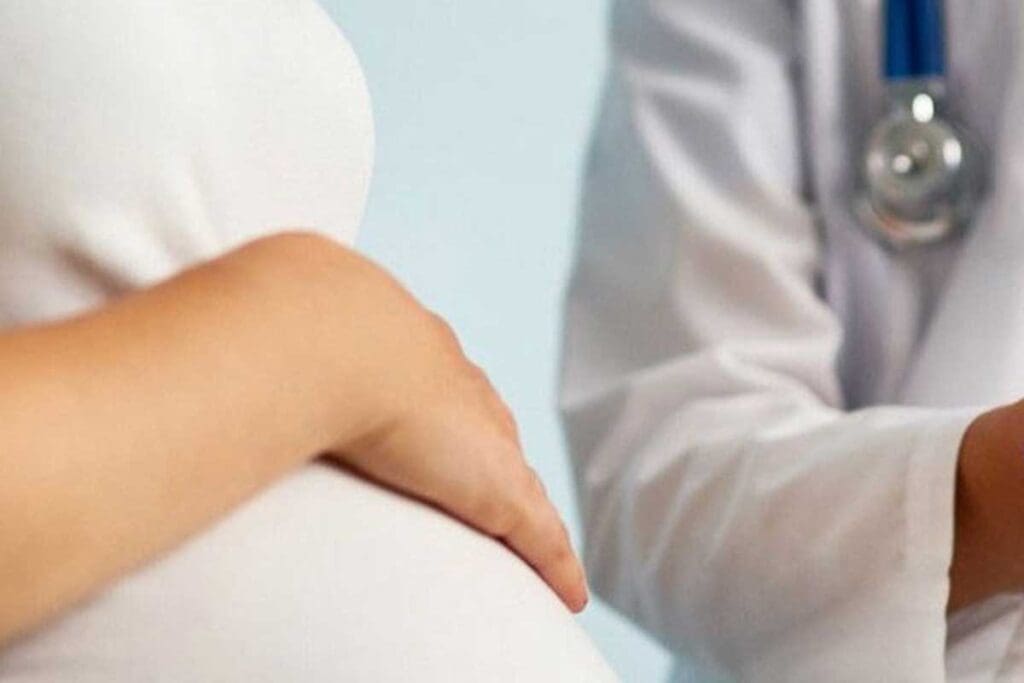Last Updated on November 17, 2025 by Ugurkan Demir
Pregnancy brings big changes to the body, and women are five times more likely to develop blood clots during this time. At Liv Hospital, we know how serious blood clots can be. They can cause deep vein thrombosis (DVT) and even pulmonary embolism (PE). It’s important for pregnant women to know the risks and watch for warning signs.

We care for our patients by teaching them about the risks and the need to stay alert to their health. Spotting blood clot signs early can save lives.
Pregnancy changes a woman’s body in many ways, including an increased risk of blood clots. The body adapts to support the growing fetus and prepare for childbirth. But these changes can lead to an increased risk of blood clots.
Pregnant women are more likely to get blood clots because of changes in blood clotting factors. The level of blood-clotting proteins increases, while anti-clotting protein levels decrease. This makes it easier for clots to form. Also, the growing uterus can press on veins in the legs and pelvis, slowing blood flow and raising the risk of clotting.
Pregnant women face a higher risk of blood clots for several reasons:
These factors make it more likely for blood clots to form. It’s important for pregnant women to know these risks and watch their health closely.

Venous thromboembolism (VTE), which includes deep vein thrombosis (DVT) and pulmonary embolism (PE), happens in about 2 in every 1,000 pregnancies. While it’s not very common, the risk is higher than in non-pregnant women of childbearing age.
Knowing the risks and recognizing the signs and symptoms of blood clots during pregnancy is key. It helps in early detection and treatment, which can save lives. We will look into the dangers of blood clots in pregnancy and their effects on both mother and baby in the next sections.
Blood clots in pregnancy are a big risk for both mom and baby. It’s important to know about these dangers. This knowledge helps us manage and reduce these risks.
Pregnant women with blood clots face serious health issues. One major danger is pulmonary embolism. This happens when a clot moves to the lungs and blocks blood flow.
Other dangers include deep vein thrombosis (DVT). DVT can cause long-term pain and swelling in the affected limb.
Blood clots can harm the placenta, leading to intrauterine growth restriction (IUGR). IUGR means the placenta doesn’t work right. This can stop the baby from getting enough nutrients and oxygen.
Antiphospholipid syndrome (APS) is another risk. It increases the chance of blood clots in the placenta. This can cause miscarriage and problems with the placenta.
There are different types of blood clots during pregnancy. These include:
The table below shows the main risks of blood clots during pregnancy:
| Type of Blood Clot | Risks to Mother | Risks to Baby |
| Deep Vein Thrombosis (DVT) | Post-thrombotic syndrome, pain, swelling | Indirect risks due to maternal health |
| Pulmonary Embolism (PE) | Blockage in lungs, potentially life-threatening | Indirect risks due to maternal health |

Leg pain or tenderness is common in pregnancy. It can also be a sign of deep vein thrombosis (DVT). DVT is serious because it’s a blood clot in a deep vein, usually in the legs. It’s important for pregnant women to know the difference between normal discomfort and DVT symptoms.
Pregnancy can cause leg discomfort due to weight gain and posture changes. But, DVT pain is usually more severe and in one leg. Normal pregnancy discomfort is often in both legs and due to muscle or ligament stretching.
Watch the pain’s intensity and location. If you have severe, persistent pain in one leg, see your doctor.
Certain symptoms with leg pain need quick medical help. These include:
If you notice these symptoms, call your healthcare provider right away. They can check if it’s DVT or something else.
DVT can cause different feelings in the affected leg, such as:
The pain from DVT can be constant or only when standing or walking. It’s a severe, ongoing ache that doesn’t go away with rest or elevation.
If you’re feeling these symptoms, get medical help. Early treatment of DVT can greatly help both the mother and baby.
Some swelling is normal in pregnancy. But swelling in just one leg or along a vein is different. It might mean you have a blood clot in a deep vein, usually in the legs.
Women often swell in pregnancy because of more blood and pressure from the growing uterus. Normal swelling is usually in both legs and gets worse at night. But, swelling that’s only in one leg, is very bad, and hurts or is red is not normal.
It’s key to tell normal swelling from the bad kind early. Normal swelling is:
When checking your legs for swelling or DVT, look for:
It’s very important to watch for these signs and tell your doctor if you see them.
To track leg swelling, measure your leg’s width at the same spot every day. Use a tape measure around the widest part of your calf or ankle. Any increase of more than 2 cm in a day or swelling in one leg means you should see a doctor.
Keeping a record of your measurements helps you and your doctor see any changes. This way, you can make better decisions about your health.
Changes in skin color or temperature can signal a blood clot during pregnancy. Blood clots are dangerous for both mom and baby. So, it’s important to spot the signs early.
Redness or discoloration in the legs can be a blood clot warning. This is often due to Deep Vein Thrombosis (DVT). The skin may look red or different, and swelling usually follows.
Key areas to watch:
Unusual warmth in the affected area is another sign. The skin might feel warmer than other parts. This is because of inflammation from the blood clot.
It’s key to tell normal pregnancy warmth from the kind that means a blood clot. If you’re not sure, talk to your healthcare provider.
If you see unusual skin changes, like redness or warmth, take photos. These can help your healthcare provider understand what’s happening.
Tips for documenting skin changes:
By watching for skin changes and knowing when to get help, pregnant women can lower blood clot risks.
Some breathlessness is normal during pregnancy because of the growing uterus. But, sudden shortness of breath or chest pain can mean a serious problem like a pulmonary embolism.
Pregnancy can change how you breathe because of the growing uterus. But, sudden and severe shortness of breath is not normal and needs checking.
Normal pregnancy breathlessness comes on slowly and doesn’t hurt. It’s not usually with chest pain or other scary symptoms. If you have any of these, get medical help right away:
A pulmonary embolism happens when a blood clot goes to the lungs. It can cause serious damage. Key warning signs are:
If you have these symptoms, get medical help right away.
If you or someone you know has severe symptoms like trouble breathing, chest pain, or coughing up blood, call 911 or your local emergency number right away.
| Symptom | Action |
| Sudden shortness of breath | Seek immediate medical help |
| Chest pain with deep breathing | Call 911 |
| Coughing up blood | Call 911 |
Diagnosing a pulmonary embolism uses clinical evaluation, imaging tests, and lab tests. Common tools include:
Knowing about these steps can help pregnant women understand their care better.
A rapid heart rate or an unexplained cough can be alarming symptoms that may suggest a blood clot during pregnancy. These symptoms can be linked to blood clots. It’s important to know when to seek medical attention.
During pregnancy, your heart rate may naturally increase. But a significantly rapid or irregular heartbeat could be a sign of a serious issue. This includes a pulmonary embolism (PE), when a blood clot travels to the lungs. We recommend monitoring your heart rate and reporting any unusual changes to your healthcare provider.
Normal heart rate during pregnancy is usually between 70 to 100 beats per minute. If your heart rate consistently goes over this range or if you experience palpitations, talk to your doctor.
An unexplained cough, with chest pain or difficulty breathing, could indicate a blood clot in the lungs. Coughing up blood is a concerning symptom that needs immediate medical attention.
If you have a persistent cough without a clear cause, like a cold or allergies, see your healthcare provider. They can check if your symptoms might be related to a blood clot or another condition.
Beyond rapid heart rate and unexplained cough, there are other symptoms to report. These include dizziness, fainting, or feeling lightheaded. These could be signs of a blood clot affecting your circulation or oxygen supply.
Also, any unusual pain or swelling in your legs, arms, or other areas should be discussed with your doctor. These could be signs of deep vein thrombosis (DVT) or another clotting issue.
It’s key for pregnant women to know the signs of blood clots. This ensures their health and their baby’s well-being. Look out for pain or tenderness in one leg, swelling, skin changes, sudden shortness of breath, or a rapid heart rate. These are warning signs to seek medical help right away.
Preventing blood clots is also important. Stay active, wear compression stockings, and drink plenty of water. Knowing the risks and taking steps to prevent them is vital.
If you notice any unusual symptoms or signs of blood clots, get medical help fast. Blood clots in pregnancy can be deadly if not treated quickly. Being informed and watchful helps protect your health and ensures a safer pregnancy.
Pregnant women face a higher risk due to several reasons. These include increased blood volume and pressure from the growing uterus. Also, changes in blood clotting factors play a role.
Blood clots are more common in pregnant women. Studies show the risk is about 5 times higher than in non-pregnant women of the same age.
Blood clots can lead to serious complications for the mother. These include pulmonary embolism, which can be life-threatening. Other risks include post-thrombotic syndrome and long-term damage to the affected limb.
Yes, blood clots can indirectly affect the baby. They can compromise the mother’s health, leading to complications. This may require early delivery or other interventions.
DVT is a blood clot in the deep veins, usually in the legs. It causes pain, tenderness, swelling, and warmth. The pain can be mild or severe and worsens when standing or walking.
Normal pregnancy discomfort is usually bilateral and related to pregnancy stage. DVT causes unilateral pain or swelling. Seek medical attention if you have persistent or severe leg pain, mainly in one leg.
Mild swelling in the feet and ankles is common due to fluid retention and increased blood volume. But significant or unilateral swelling, with pain or redness, could indicate a blood clot.
Monitor leg swelling by regularly measuring the circumference of your legs at the same point. An increase in swelling, if asymmetric, should be reported to your healthcare provider.
Skin changes like redness, discoloration, and unusual warmth in the affected area could indicate a blood clot. Documenting these changes is helpful for medical evaluation.
Sudden shortness of breath or chest pain can be signs of a pulmonary embolism, a life-threatening condition. If you experience these symptoms, call emergency services immediately.
Yes, a rapid heart rate or an unexplained cough can be symptoms associated with blood clots, like pulmonary embolism. Any unusual or persistent symptoms should be reported to your healthcare provider.
Yes, preventive measures include staying hydrated and avoiding prolonged immobility. Also, follow any specific recommendations from your healthcare provider, if you have risk factors for blood clots.
Subscribe to our e-newsletter to stay informed about the latest innovations in the world of health and exclusive offers!